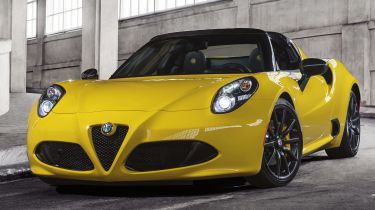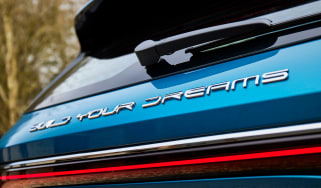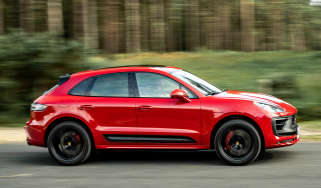Alfa Romeo 4C Spider convertible (2015-2019)
“Like its coupe equivalent, the Alfa Romeo 4C Spider is a beautiful but flawed sports car”
Pros
- Gorgeous looks
- Great sounding engine
- Italian sports car pedigree
Cons
- Difficult handling
- Hesitant power delivery
- Impractical, even for a sports car
The Alfa Romeo 4C Spider is a convertible version of the enticing – but flawed – Alfa Romeo 4C coupe. It competes with other sports cars like the Porsche Boxster and Lotus Evora, while if you’re thinking of buying a 4C Spider, you might also consider a more comfort-focused (yet still entertaining) roadster like the BMW Z4 or Mercedes SLC.
The Alfa Romeo 4C Spider is an alluring – if expensive – car that’s likely to be bought with your heart rather than your head. It’s a beautiful and fast convertible with supercar-inspired carbon-fibre underpinnings, yet it’s difficult to drive smoothly and its interior doesn’t justify the expensive asking price.
While nobody buys a convertible sports car with trips to the dump in mind, the 4C Spider is also quite impractical: the fabric roof can only be removed when the car is stationary and it has to be stored in the (already small) boot. A Porsche Boxster has a far more useable amount of luggage space, as well as an electrically operated folding roof, for instance.
Despite these reservations, there’s something special about the 4C Spider. If you can overlook its compromises and are happy with how it drives, owning a carbon-fibre Alfa Romeo may be all the justification you need.
MPG, running costs & CO2
Because Alfa Romeo has fitted a relatively small 1.75-litre engine to the 4C Spider, it’s impressively economical for a sports car. It’s slightly less efficient than the 4C coupe – partly due to aerodynamic compromises from removing the roof – but fuel economy of 40.9mpg and CO2 emissions of 161g/km (for an annual road-tax bill of £180) are excellent for a car that can go from 0-62mph in just 4.5 seconds.
More reviews
In-depth reviews
All 46 of the brand's dealerships across the UK are capable of servicing the 4C and Alfa offers fixed-price service plans for the 4C. It'll cost £1,999 for a three year service plan that incorporates all parts and labour for all three major services scheduled to take place during that time.
Engines, drive & performance
A sports car lives or dies by how fast it is and how well it drives and in this regard, the 4C Spider is something of a mixed bag. Alfa Romeo only offers the 4C Spider with a 237bhp 1.75-litre turbocharged petrol engine, and it certainly has plenty of power – enough to take the car from 0-62mph in just 4.5 seconds and on to a top speed of 160mph. The engine sounds the part, too, with pleasingly sporty rasps from the exhaust when changing gear.
Unfortunately, there’s a notable delay when you press the accelerator, before the power is delivered all at once in a surge. This makes the 4C Spider tricky to drive smoothly. Its steering is also difficult: the slightest bump in the road causes the wheel to writhe about in your hands, even in a straight line, so the 4C Spider feels particularly unsettled on rough roads and at speed.
Despite this, there’s plenty of ‘feel’ from the steering wheel, although there’s no power steering, so low-speed manoeuvring is hard work. On a sunny day with the roof off, though, the 4C Spider is an intoxicating – and seriously quick – car to drive. It’s for moments like these that most people will buy one.
Interior & comfort
The Alfa Romeo 4C is let down bad ride comfort and a poor-quality interior. While sports car owners tend to want to feel connected to the road and are willing to sacrifice some comfort in order to achieve this, the 4C Spider is significantly inferior to the Porsche Boxster when it comes to ride quality.
The 4C spider is also uncomfortable over bumps, due to its stiff suspension. While sports cars tend to have firm suspension in the pursuit of driving thrills, the Alfa doesn’t make up for this with an excellent driving experience. It crashes over potholes and imperfections in the tarmac and this is exaggerated by its ultra-stiff carbon-fibre underpinnings, tricky steering and lag in power delivery.
The interior is made of poor-quality plastics and while many will like the visible carbon-fibre ‘weave’ on display, this is likely to become scratched quite easily. There is some evidence of the 4C’s price: a TFT screen replaces the traditional speedometer and rev counter, while standard aluminium pedals and a flat-bottomed steering wheel add to the sporty ambiance.
Practicality & boot space
The Alfa’s 110-litre boot is tiny and not brilliantly shaped, and not only do you have to lift any bags over the bodywork in order to load them, but the bootlid also has to be propped open with a strut – much like a car bonnet. And rather than a conventional folding roof that’s stored under a body panel, the 4C Spider’s roof has to be completely removed by hand if you want open-top thrills. Storing it eats into what little boot space there already is, too.
Things aren’t much better inside. While the Porsche Boxster has a decent-sized glovebox, there are no such concessions in the 4C: the only storage spaces are a leather pouch between the seats and a net under the dashboard. There is, at least, a cup-holder – although you have to reach behind the handbrake to access it.
Reliability & safety
Alfa Romeo doesn’t have the best reputation for reliability and this was highlighted by a 23rd-place finish (out of 32 manufacturers) in our 2015 Driver Power customer satisfaction survey, with an even poorer 30th-place finish for reliability. But 4C buyers should be reassured by the fact that its engine has been used in other Alfa models and is likely to be pretty dependable as a result.
While the 4C coupe and Spider aren’t built in big enough numbers to have gone through Euro NCAP safety tests, carbon-fibre is known to be incredibly strong, so the 4C Spider should perform well if the worst happens. Note that if you damage your 4C in a crash, one of the disadvantages of carbon-fibre is that it’s extremely difficult to repair. Any serious incidents are more likely to see the car written off by your insurer than repaired.
Price, value for money & options
The extent to which the Alfa Romeo 4C Spider provides value for money is largely down to your perspective. Some will consider a carbon-fibre sports car for this price a bargain, as cars built from such exotic materials typically cost upwards of six figures. Others will bemoan the lack of sat nav and consider than the poor quality of the interior plastics unacceptable in such an expensive product.
The 4C Spider costs around £8,000 more than the coupe. While this seems a is a lot, Alfa Romeo does at least give it extra equipment, such as cruise control and parking sensors, as well as some additional exterior carbon-fibre detailing.
In terms of options, 4C Spider customers can specify exclusive yellow paint and there’s also the option of adding extra carbon-fibre detailing – both inside and out – which is likely to be a popular choice. The Spider also gets some exclusive optional alloy wheel designs you can’t have one the coupe.












